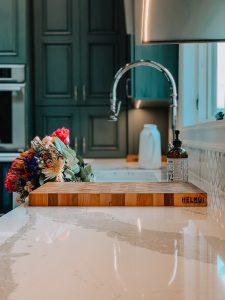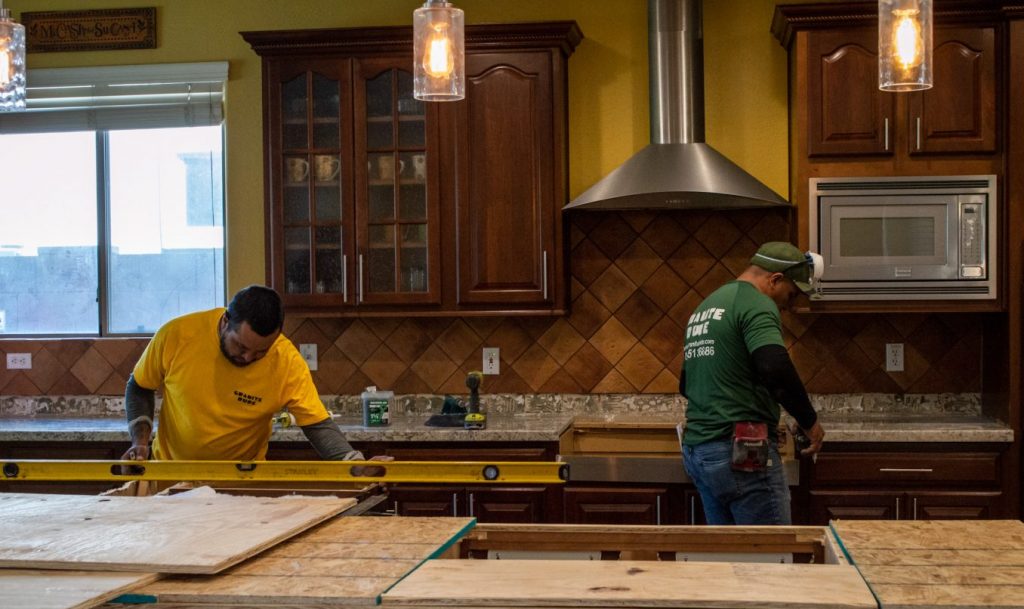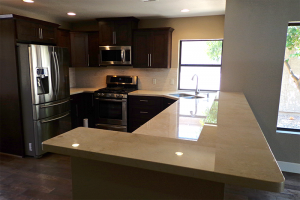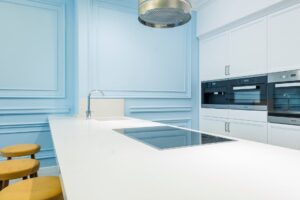- The Basics of Quartz Countertops
- How To Install Quartz Countertop
- Putting up a Quartz Countertop: A How-To
- Quartz Countertops Offer Various Pros and Cons
Contrary to general belief, quartz is not a synthetic substance. Quartz is the most prevalent mineral on Earth and is a naturally occurring mineral made of silicon and oxygen, according to Geology.com.
The Basics of Quartz Countertops
The primary ingredient in quartz countertops, quartz, is a naturally occurring mineral, yet humans manufacture quartz countertops. It causes misunderstanding over whether quartz is natural or artificial.
Quartz surfaces are made of manufactured stone. They mix the most significant aspects of contemporary production techniques with natural stone. It produces a more durable surface and aesthetic appeal on par with or often even better than granite and marble.
Quartz countertops are created by mixing natural and synthetic components like polymers, resins, and colors with natural quartz that has been ground into a fine powder.
While adding pigments to give the countertop color, resins and polymers glue the quartz together to make it challenging and long-lasting. Repurposed glass or metal flecks are occasionally used to liven up the design.
The final product is mainly made of natural quartz, which accounts for 90%.
How To Install Quartz Countertop
Quartz countertop installation is not a weekend DIY task. Qualified personnel must measure, level, and fasten the slaps to the cabinets or island.
Due to its tremendous weight, which may be between 20 and 25 pounds per square foot, quartz is more challenging to install. Installers must ensure the ground is stable and robust enough to support the weight of the quartz.
Installers must properly place each stab to reduce the visibility of steams. This assignment might be easy or hard, depending on the design and colors.
Made Only for Indoor Use
When exposed to prolonged direct sunlight, quartz worktops deteriorate, so pick another material if installing an outdoor kitchen.
Your countertops will acquire an ugly yellow tint due to the pigments fading under the UV rays.
Be cautious when selecting quartz for rooms with expansive windows that receive much sunlight since even direct UV rays from the sun can fade the hues over time.
Putting up a Quartz Countertop: A How-To
For kitchen remodels, quartz worktops are a popular option. Quartz has a glossy surface and is heat, stain, and scratch-resistant. As a result, it is a classic and long-lasting material that will look great for many years. Quartz countertops may be made to fit any kitchen and are simple to install. Here are some straightforward instructions to follow if you consider installing a quartz countertop.
Step 1: Measure Materials
To determine the size of countertops you require, measure the counter space. If using a backsplash, remember to consider it. It would help if you bought a countertop that is the exact size of the room or more excellent and then cut it down. Use painter’s tape to highlight the areas of the quartz that need to be cut if you receive one that needs to be cut or trimmed.
Step 2: Choose and Order your Quartz
There are many options. Prioritize choosing a pattern and color for your kitchen when browsing the many alternatives. Quartz countertops come in simple blacks and whites with elegant marble accents to intricately fashioned surfaces that faithfully mimic stone.
Choose the appropriate thickness next. The majority of quartz is sold in kitchens in 1-1/4-inch slabs. Finally, decide which edge you like. There are square, waterfall, round, and curved edges available. Unpolished edges are required to create seams between slabs, but your remaining edging options should be determined by the area’s design or your preferences.
Step 3: Prepare the Area
Spend time preparing the space where you will put the countertops after placing your slab purchase. Start by removing any existing counters or surfaces to reveal the cabinets only. Check the alignment of the cabinet tops with a level. To produce a perfectly level surface throughout the whole countertop area, use wooden shims as necessary. Be sure to turn off your water as well. Before installing the countertops, stain, seal, or paint the cabinets and let them dry.
Step 4: Dry Fit Your Quartz
When your quartz slabs arrive, carefully lay them out on the tops of your cabinets in the precise locations, you want to put them. Get assistance moving the slabs because they probably won’t be light.
If you have one quartz slab, ensure it fits well without creating any noticeable gaps. Make sure the quartz slabs go together correctly if you bought many of them to make a more complicated countertop. Make sure the sink fits properly by slipping it into the designated location.
Installation can start if all of the slabs fit together correctly. On the other hand, if the quartz has to be adjusted, mark the areas where cuts need to be made with a pencil and painter’s tape. Cut using a diamond blade and a circular saw.
Step 5: Install your Sink
Be sure to take out the quartz slabs before you install your sink. Keep the slabs straight while storing them to avoid damage. Additionally, because the slabs are so heavy, always ask for assistance while lifting them. Clear the space, then place your sink in the appropriate location. Make sure there is enough assistance. Wait until the countertop construction is finished before adding plumbing.
Step 6: Install the Ledgers
Unlike granite, quartz countertops don’t need underlayment or sub counters for further support. On the other hand, quartz countertops may be positioned right on top of the cabinets. Quartz counters are hefty, though, and may occasionally require additional support.
Look at the countertop configuration and look for areas where the cabinet support is insufficient. Install ledger boards as necessary; for instance, if you add a desktop to a site that lacks appropriate support or places a counter across a large dishwasher. It usually offers adequate support to fasten 1 to 2-inch ledgers into the cabinet siding or wall.
Step 7: Protect your Cabinets
Spend some time shielding your cabinet faces before setting the quartz slabs. It would be best to use painter’s tape around the top cabinet edges to prevent silicone adhesive from contacting the cabinet faces. Removing the video before the glue dries is essential.
Step 8: Install your Quartz Countertop
Install your quartz slabs one piece at a time, starting with the area around the sink. To secure the slab in place, apply silicone adhesive to the tops of the cabinets underneath. To ensure the counter is firmly attached, space silicone glue beads 6 to 12 inches apart.
With assistance, drop the slab into position while the adhesive is still wet. Repeat for the remaining slabs, gently pressing each one to ensure it is completely fastened to the cabinets below.
The joints will need to be sealed if you’re utilizing many slabs. It would be best if you used painter’s tape to seal the seams on both sides at the top. Put silicone glue or another substance on the junction as directed. Fill the seam, then allow the fabric to air dry. Before the silicone has dried, remove the painter’s tape. Before utilizing, let the countertop sit for the night.
Step 9: Final Steps
You may connect your drain and sink once your countertop is completely fitted. You’re good to go after you turn the water back on!
Quartz Countertops Offer Various Pros and Cons
Let’s grasp the advantages and disadvantages of quartz countertops for your home and business establishments.
Quartz countertops’ benefits
Numerous benefits of quartz countertops include their sturdiness, beauty, and stain resistance. Here is a thorough list of why you should consider choosing quartz for your countertops if you need further encouragement.
Durability
The extreme strength of quartz countertops is one of the primary reasons people acquire them. Quartz is the perfect material to choose if you want something that won’t readily chip, scratch, or break.
The Italian business Breton developed the method for producing engineered quartz stone in 1963 to use the abundant supply of quartz to have a material that would be more durable than stone.
Additionally, adding pigments and other elements throughout the production process could provide an infinite number of patterns.
Thankfully, Breton’s idea was realized, and quartz worktops are now among the most resilient surfaces you can have in your house.
Quartz scored 7 out of 10 on the Mohs scale of mineral hardness, which geologists use to assess the hardness and scratch resistance of minerals on a range of 1 to 10 (10 being the most challenging/most scratch resistant). In comparison, marble is typically graded between 3 and 5, while diamond is rated 10.
Quartz is resilient. However, this does not indicate that it is unbreakable. Quartz can be scratched or chipped, although the likelihood of damage from regular, everyday use is relatively low due to the material’s robust nature.
Warranty
Most manufacturers give extensive guarantees because they are so sure of the toughness of quartz countertops. The leading manufacturers of quartz countertops have supplied the warranty conditions shown below.
Appearance
Another benefit is the range of stylish, streamlined, and contemporary styles available for quartz countertops.
Manufacturers of quartz countertops may use pigments and other materials, such as recycled glass and metal flecks, to produce practically any design and color you choose.
With quartz, unlike natural stones like granite, you are not constrained by the patterns that Mother Nature offers.
Quartz countertops may be made to match any flooring, backsplash, cabinet material, or cabinet color. Solid-colored countertops, like the one in the photo below, are rapidly gaining popularity in addition to conventional stone-like patterns, particularly in contemporary homes.
Most manufacturers provide patterns that appear pretty similar to those of granite and marble if you want quartz’s longevity and minimal maintenance but still desire the veining and individuality of natural stone. The choices with quartz are almost unlimited, so you can obtain whatever pattern you wish.
Non-Porous
Engineered quartz countertops are non-porous, in contrast to natural stones, which have tiny pores all over them.
Porous materials allow liquids to infiltrate through their surface and cause permanent damage, such as discoloration and staining.
Even worse, it might be challenging to clean and disinfect when bacteria and germs get into pores. Homeowners using natural stone worktops must maintain them adequately sealed as a result.
You won’t need to be bothered about any of it with quartz. You don’t need to seal it because it is non-porous, and you never have to be worried about fluids or bacteria entering the surface.
It brings me to the stain resistance and minimal maintenance features of quartz countertops that I’ll discuss next.
Inability to stain
The non-porous nature of quartz countertops makes them exceptionally stain-resistant.
When liquid from a spill seeps into the stone’s pores, stains on countertops are frequently the result. Due to their porous nature, marble and granite are more prone to stains. Older kitchens with stone worktops may show white spots, yellowing, and fading if you look closely, especially if the owner neglected to reseal the surface regularly.
Look at a little but evident stain that is very hard to remove from a marble countertop.
Quartz is non-porous, so even if you neglect to clean up spills straight away, there is no way for liquids to penetrate in and produce stains. It is a crucial selling element for most homeowners, especially families with small children.
In a test, Consumer Reports applied blotches of various substances, including coffee, grape juice, and vegetable oil, on quartz and granite surfaces and allowed them to sit for 20 hours. While both materials demonstrated good stain resistance, quartz outperformed granite in several stain categories, including beet juice and food coloring.
Quartz is not stain-proof, yet it is stain-resistant. 10% of quartz countertops are made of resins and pigments, which certain substances can damage. Avoid coming into touch with oil-based soaps, bleach, high pH cleansers, permanent markers, paint, paint remover, and nail polish. Your quartz countertops might become stained and damaged if exposed to certain substances.
Easily Maintained
Quartz countertops require little to no upkeep, which is one of the primary reasons people choose them.
Forget about sealing granite countertops as is being discussed. With quartz, sealing is never an issue, and cleaning is simple. Use soap and water to clean them down. But with quartz, there’s not much to worry about and not much to do. With other materials, notably marble, you have to pay great attention to everything that comes into touch with it.
Your countertops shouldn’t be one of the many home maintenance tasks you must worry about.
Versatility
In addition to kitchen worktops, quartz is a terrific material for bathrooms, fireplaces, bars, and other spaces in your house. Due to its durability and range of colors and patterns, it is a material that can be used in many applications.
Quartz has a practically infinite number of uses, whereas other materials are constrained by their construction and capacity to tolerate certain elements.
The drawbacks of quartz countertops
I’ve already discussed all the fantastic qualities of quartz countertops, but you also need to be aware of the drawbacks before you phone your builder and order many stabs. These are the reasons why quartz countertops might not be for you.
Price
If money is scarce, you might want to consider alternatives to quartz. The durability, non-porousness, and customizability of quartz are all beautiful qualities, but they come at a price.
The cost of quartz countertops, including installation, can range from $50 to $150 per square foot, but the final price may depend on the manufacturer, quartz quality, style, design, and edging choice.
The price will also vary depending on the number of slabs and finishes. The cost will increase if you require additional cuts for equipment like sinks and soap dispensers.
Quartz is pricy, but the alternatives, genuine stones, are also expensive. Quartz countertops typically cost $75 per square foot, marble $60 per square foot, and granite $40 to $60 per square foot, according to HomeAdvisor.com.
Appearance
Quartz can be made to practically any pattern you can think of. Although the variety of its appearance is a clear benefit, granite or marble may be preferable if you want a genuinely distinctive design in natural stone.
Engineered quartz can replicate the appearance of genuine stone thanks to advancements in technology, but it can’t equal the natural stone’s beautiful waves and veining.
Additionally, it may be more challenging to hide the seams where two slabs meet depending on the color and design, particularly with light-colored counters. Darker hues can help with this problem, although they still stand out more than granite.
Quartz is a beautiful material, yet some think it looks phony and cheap. Bottom line: Quartz has endless design possibilities, but it’s hard to match the unique and exotic patterns you get with natural stone.
Damage from Heat Prone
Quartz can withstand heat, but not resin and polymer fillings. Hot cookware might melt the resins in quartz surfaces, resulting in lasting discoloration and damage. The presence of white spots and cloudiness indicates heat damage.
According to some specialists, quartz can withstand temperatures of up to 300 degrees without suffering harm, but only 150 degrees, according to others.
The quality and manufacturer affect the precise temperature threshold. Nevertheless, always place a trivet or cushion between hot cookware and quartz counters for your protection.
According to testimonies from homeowners, even the heat of warm dishes placed directly on top of quartz countertops after being taken right out of the dishwasher can burn the resin binders and result in long-term damage.
The most popular countertops available right now are made of quartz.
They have supplanted granite, the old king, as the premium surface of choice for domestic and industrial purposes.
Choosing your countertop is one of the most exciting parts of upgrading your kitchen or designing a new one. They not only offer a sturdy surface for cooking, dining, and entertaining, but they also serve as the kitchen’s major attraction, which everyone sees straight away.
It’s crucial to pick the proper material for your kitchen countertops. You have many alternatives, including those made of concrete, wood, granite, and marble. They are excellent options, but quartz is now outpacing the others in demand.
Contact Granite Dude for Your Quartz Countertop Installation Today!
You’ve come to the exact spot if you’re considering installing quartz countertops but aren’t sure if it’s the perfect material for your kitchen. Granite Dude is ready to help when it comes to your quartz countertop installation. Contact us today!









